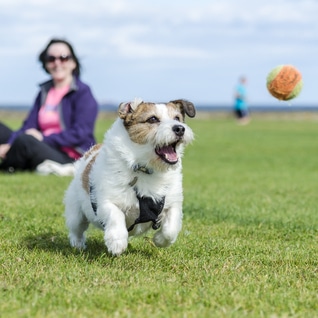Behavior, Everything, Cats, Dogs
Games Animals Play
Kids call it Cops and Robbers. To cats and dogs, the premise of the game is the same, but the players are different. While rabbits see things a little differently, they can get into the fun too.
When we’re one of the players, playing becomes a way to bond with our pets more and have fun ourselves. Playing also provides our pets with exercise and a positive outlet for aggression.
Cats and play
If it moves, it grooves. From the time kittens open their eyes, their hunting instinct pushes them to pursue anything in motion. They learn to hunt by playing first, and if something doesn’t move, they’ll try to induce it to move.
Kittens and younger cats hardly need an invitation to play. In fact, if you aren’t careful, unintentional invitations pop up around the home. Dangling toilet paper, for example, becomes a toy that kittens can drag until the roll runs out of paper. Kittens can also pull down clothes hanging over a chair, or an electrical cord hanging over the edge of a counter or ironing board.
The slithery movements of a piece of twine or an old belt jerked along the floor draw out cats’ instinct to stalk, crouch, and pounce. Once the object stops moving, the fun is over, so the name of the game is to keep the object moving at various speeds. But do let your cat win eventually, before she gets bored of the game.
Spend a few dollars for made-for-cat balls, and the games continue even when you aren’t there. Cat balls should roll easily with the bat of a paw, and if they make a sound when they move, they’re even more fun.
Pet shops carry interactive toys for cats and their people, from wands with tails to mice with computer-generated movement. Some toys require human participation, and others don’t. Make the toys the prey and not your hands; cats should learn as young as possible not to bite or scratch, even in play. Put most toys away between play sessions to prevent boredom from familiarity, and the games will be exciting for longer.
Dogs and play
Like cats, dogs have a hunting instinct, but their interest in play goes beyond chasing imaginary prey.
Frisbee catch is a way to expand the usual ball catch game. Dog frisbee, or flying disc, has become a popular organized sport, with clubs and activities in various US cities. The Frisbee Dog Page has links to sites about training, clubs, and other resources for disc sports for dogs.
Dogs need to play with each other as well as with people to develop their dog-to-dog social skills. Observe the body language when dogs are together, and you’ll see when they’re playing — front legs lowered in a play bow, ears forward or relaxed. When they’re being aggressive, the body language is different — ears back, stiff posture.
Dogs want to please people. With training, they can learn to play games with their people such as hide and seek and treasure hunt. They can also enjoy agility activities, sledding, flyball (a relay sport with dogs), and more. The following sites have descriptions of some activities you can do with your dog:
Rabbits and play
In the wild, rabbits are prey, so naturally they tend to be timid. Always approach a rabbit from the front, where he can see you. Get down to his level. After he gets to know you and feels safe with you, the games can begin.
To rabbits, play usually involves nibbling, digging, shredding, pushing, climbing, and burrowing. Not all rabbits like to play, but those that do often enjoy playing with cat toys, or even just paper to shred. (Use only paper with black ink; colored ink may contain harmful chemicals.) Toilet paper rolls with food in them can also provide entertainment. It’s a good idea to leave a few shreddable, chewable, and moveable objects in the play area before rabbits think about turning your furniture and personal items into toys. Be careful that toys don’t have openings big enough for paws to get caught in, and don’t give rabbits toys with paint or varnish on them — rabbits will chew them.
Let the rabbit set the pace of play time. Put new toys in front of him (but not too close at first) and let him sniff them. Praise him if he plays with them, and accept that sometimes he won’t. Rotate the toys so that he doesn’t get bored.
Summary
- Find out what kind of play your cat, dog, or rabbit is best suited for.
- Make play time fun for both you and your pet.
- Keep play safe and interesting, with lots of variety.


